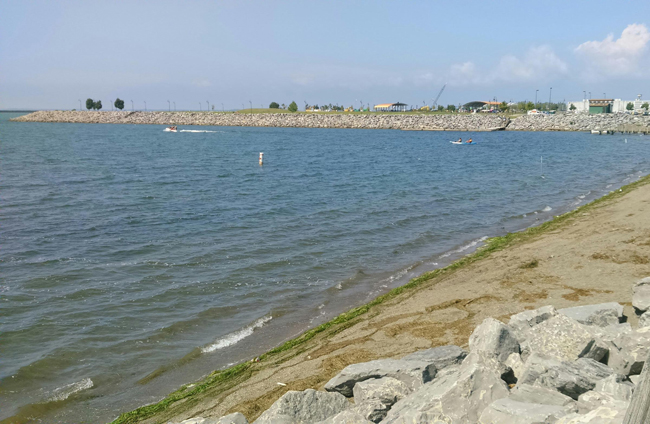By Angelica A. Morrison, WBFO 88.7 FM Radio, Buffalo's NPR News Station

Gallagher Beach on Lake Erie, August 2016. Photo: Angelica A. Morrison/WBFO
This audio clip is from a discussion on WBFO radio. Based in Buffalo NY, WBFO 88.3 FM is a part of the National Public Radio digital network. If you don't see the player above, it's because you're using a non-Flash device (eg, iPhone or iPad). You can download the mp3 file by clicking here (mp3). It may take a few minutes to download, so please be patient.
Buffalo, NY, August 26, 2016 - Each summer, bacteria can force beaches on the Great Lakes to close. Now researchers are battling the bacteria with a genetic-based process.
The technique, called Next Generation Sequencing, involves looking at bacteria at the molecular level. Samples of the bacteria's DNA are collected from the water, and are examined to help with identifying the source of he problem.
Researchers at the Buffalo State Great Lakes Center will be using the technology in Lake Erie. They'll collect samples near an area that has been plagued by bacteria: Gallagher Beach on Buffalo's Outer Harbor.
The accumulation of bacteria can sicken people and pets. And it has triggered restrictions at Gallagher Beach.
Right now, it's unknown if the technique is used by other communities in the Great Lakes region, but researchers at the center say the process has been around for four or five years.
"There's an emphasis on water quality throughout the Great Lakes basin and ... we are involved in a lot of water quality testing and issues and so on as part of a larger scheme for Buffalo State," said Gary Pettibone, one of the key researchers on the project.
He says they will take samples from several sites along the Gallagher Beach area, to determine the bacteria's source. The project will take about a year to complete.
Some suspected sources of the bacteria: a storm drain and a seagull nesting colony.
More Info: Water Quality Under the Microscope
New York Congressman Brian Higgins recently announced New York Sea Grant's support for a new water quality study being conducted by Buffalo State Great Lakes Center at Gallagher Pier on Buffalo’s Outer Harbor.
“There is great public demand to make Gallagher Beach a full swimming beach,” said Higgins at a August 26th press conference on the Pier. “Although it is closed to swimming today we don’t need to sit back and simply accept that as the long-term fate for Gallagher Beach."
For more, see "NYSG Awards Buffalo State Researchers Nearly $12K to study water at Gallagher Pier."
More Info: New York Sea Grant
New York Sea Grant (NYSG), a cooperative program of Cornell University
and the State University of New York, is one of 33 university-based
programs under the National Sea Grant College Program (NSGCP) of the
National Oceanic and Atmospheric Administration (NOAA). The NSGCP
engages this network of the nation’s top universities in conducting
scientific research, education, training and extension projects designed
to foster science-based decisions about the use and conservation of our
aquatic resources. Through its statewide network of integrated
services, NYSG has been promoting coastal vitality, environmental
sustainability, and citizen awareness about the State’s marine and Great
Lakes resources since 1971.
New York Sea Grant maintains Great Lakes offices at SUNY Buffalo, the
Wayne County Cooperative Extension office in Newark and at SUNY Oswego.
In the State's marine waters, NYSG has offices at Stony Brook University
and Stony Brook Manhattan, in the Hudson Valley through Cooperative
Extension in Kingston and at Brooklyn College.
For updates on Sea Grant activities: www.nyseagrant.org has RSS, Facebook, Twitter, and YouTube links. NYSG also offers a free e-list sign up via www.nyseagrant.org/coastlines for its flagship publication, NY Coastlines/Currents, which is published several times a year.